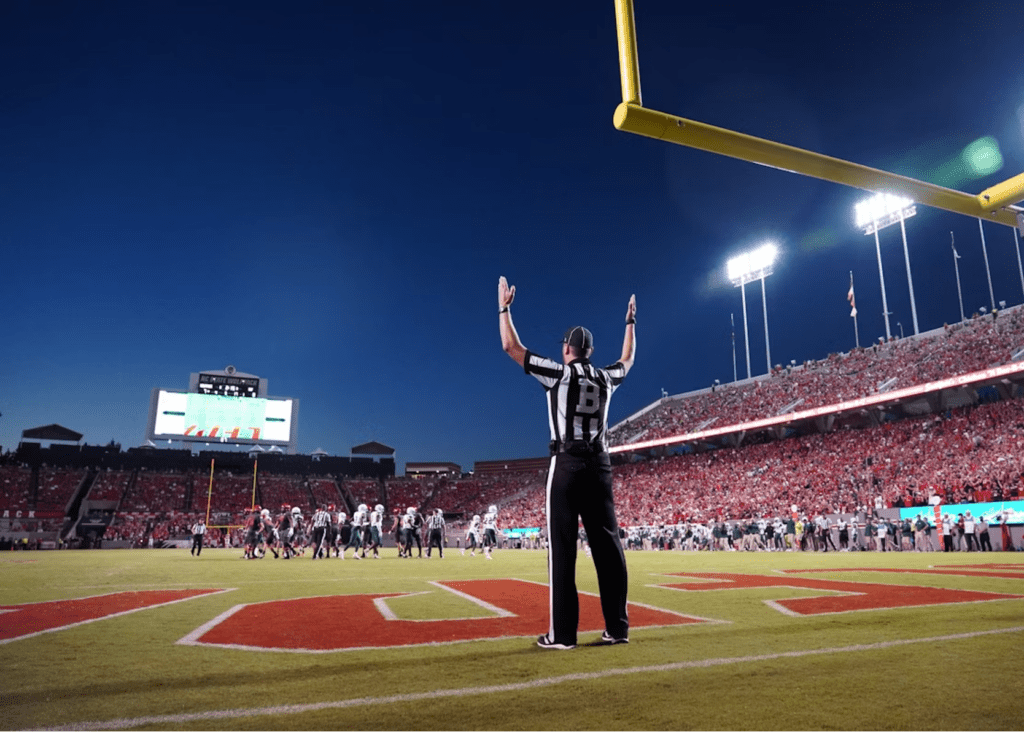College football draws millions of fans across the United States every fall, and with it comes a surge of online betting activity. From late August through early January, bettors track matchups, rankings, and odds across conferences and bowl games.
What sets the NCAAF season apart is its structure – games are packed into Saturdays, teams change rapidly week to week, and regional rivalries stir strong public interest.
Unlike professional leagues, betting on college football often includes more volatility and fewer standard metrics.
Most online betting happens legally through regulated sites, where lines update based on injuries, weather, and public movement. Bettors across legal states participate every week, placing wagers before and during games.
Whether it’s a regular-season clash or a championship-deciding bowl, each matchup creates a new board to read. Understanding how online betting works within this unique schedule helps explain why college football remains a central focus for bettors each season.
College Football Betting Fundamentals Explained
College football betting is built around weekly cycles. With most games taking place on Saturdays, oddsmakers publish early lines by Sunday or Monday. These initial numbers reflect power rankings, statistical trends, and public perception. As kickoff nears, line movement becomes more active, based on team news and betting volume.
There are three primary bet types used throughout the NCAAF season. The point spread assigns a margin of victory that a favorite must cover. Totals, often called over/under, set a combined score for both teams. Moneyline bets involve picking a team to win outright, regardless of the score differential. These formats appear every week, from non-conference openers to rivalry clashes in November.
The volume of online bets fluctuates throughout the season. Early games in September attract modest interest as teams establish form. By October, conference games draw heavier action. As playoff implications grow in November, betting activity increases sharply. Bowl season and the College Football Playoff cap the year with the highest stakes and the most diverse wagers.
Betting Opportunities Across the NCAAF Season
The season’s rhythm creates distinct betting phases, each shaped by timing, data, and public interest.
Futures and Preseason Wagers
Before the first snap, futures markets allow bets on conference champions, win totals, and national title contenders. These wagers reflect early forecasts built around recruiting classes, returning starters, and offseason coaching moves. Odds are shaped by preseason polls and betting volume, often locking in potential value before live action begins.
Weekly Line Movement Trends
Once the season starts, weekly markets adjust quickly. Lines often shift between Sunday night and Saturday morning based on new information. Injuries, suspensions, college football news, and even weather forecasts can all cause odds to move. For example, a late scratch at quarterback can tilt a spread by several points. Oddsmakers aim to balance action on both sides, so movement reflects both insider updates and public betting trends.
In-Game Betting During Live Matches
Live betting options expand dramatically during each game. Bettors can wager on updated spreads, adjusted totals, or team performance within specific quarters. Momentum changes, such as a turnover or a missed field goal, often trigger immediate odds updates. These real-time bets offer dynamic opportunities for those watching closely, especially in high-scoring or closely contested games.
Game Day Patterns That Influence College Football Betting
Game day brings a different tempo to online betting. Saturdays dominate the college football calendar, with early lines often closing minutes before kickoff.
Today, most bets are placed through an online betting platform, where odds update in real time and wagers must be finalized before game locks. The volume of bets spikes in the hours leading up to noon games, with a second wave just before primetime matchups. Deadlines create urgency, especially for those tracking injuries or late lineup changes.
Rivalry games amplify interest. Matchups like Auburn vs Alabama or Ohio State vs Michigan draw nationwide action regardless of rankings. These games often feature tighter spreads and more volatile movement. The emotional weight behind these rivalries makes them some of the most anticipated and heavily bet events on the calendar.
Live betting reaches its peak during these matchups. As fans stream games or track stats in real time, the ability to bet on halves, alternate lines, or specific outcomes becomes part of the game-day experience. The combination of access, urgency, and visibility creates continuous engagement throughout the slate.
College Betting Rules and Restrictions Explained
Betting on college football is subject to unique legal limitations, many of which vary by state. Some jurisdictions do not allow player-specific wagers, such as rushing yards or touchdown props. These rules aim to protect student-athletes while still permitting team-based bets.
Geofencing is used to verify location, ensuring that users can only place bets in approved regions. If someone travels across state lines, the betting interface adjusts automatically to comply with local law. This layer of enforcement works alongside age verification, which typically requires government-issued identification to confirm the user is at least 21 years old.
These safeguards shape how platforms offer college football odds, often reducing available options compared to professional leagues. However, core bet types like spreads, totals, and moneylines remain accessible in most legal markets.
From Regular Season to Bowl Game Bets
As the season transitions into December, betting volume shifts toward championship weekend and the upcoming bowl games. Conference title matchups offer clear stakes and matchups between top-tier programs, making them a magnet for bets.
Bowl season introduces new challenges. Many teams deal with opt-outs, where players skip games to prepare for the NFL draft. Coaching changes and interim staff also become common. These changes create uncertainty around team motivation and focus, which can affect how odds open and move.
The College Football Playoff drives the largest betting interest. With national attention and major implications, spreads and totals often fluctuate dramatically.
Public perception, betting volume, and injury rumors all play a larger role in these high-profile matchups. While betting formats remain the same, the level of attention and volatility ramps up significantly in the final weeks of the NCAAF season.


 Edward Wendt – Senior Sports Analyst
Edward Wendt is the Senior Sports Analyst at Gamble Wins Daily, bringing a wealth of knowledge and expertise in sports analytics and betting strategies. His sharp analysis and accurate predictions have made him a trusted voice for bettors looking to maximize their profits. Edward’s commitment to delivering in-depth analysis and actionable advice helps readers make informed decisions across a wide range of sports.
Edward Wendt – Senior Sports Analyst
Edward Wendt is the Senior Sports Analyst at Gamble Wins Daily, bringing a wealth of knowledge and expertise in sports analytics and betting strategies. His sharp analysis and accurate predictions have made him a trusted voice for bettors looking to maximize their profits. Edward’s commitment to delivering in-depth analysis and actionable advice helps readers make informed decisions across a wide range of sports.
